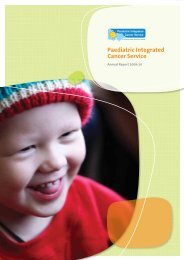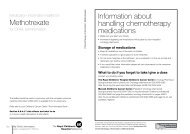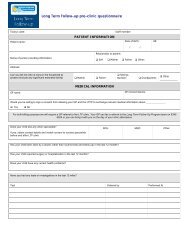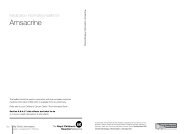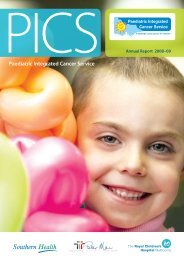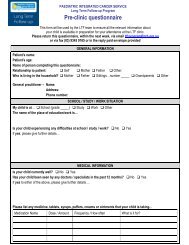The information book - Paediatric Integrated Cancer Service
The information book - Paediatric Integrated Cancer Service
The information book - Paediatric Integrated Cancer Service
Create successful ePaper yourself
Turn your PDF publications into a flip-book with our unique Google optimized e-Paper software.
• When visiting households with a pet the same precautions apply, regarding<br />
hygiene and pet health.<br />
• Children on chemotherapy treatment should avoid animals like reptiles,<br />
(snakes, lizards, geckos and terrapins) wild birds and non human primates<br />
such as monkeys.<br />
Horses: regular contact is not recommended, particularly grooming and<br />
mucking out stables.<br />
Birds: can carry disease. Don’t keep caged birds inside. Don’t let your child<br />
clean out the cage.<br />
Farm animals: limited contact allowed, taking care of good hygiene especially<br />
footwear.<br />
New pets: Check with your Consultant Oncologist for the right time to get a<br />
new family pet. This new pet should be checked by veterinarian before bringing<br />
them into your home. Hygiene and sanitary conditions can vary considerably<br />
between pet stores, animal breeders and animal shelter.<br />
When obtaining a new pet, children who are on chemotherapy treatment<br />
should avoid animals less than 6 months of age (or for cats less than 1 year<br />
of age) and especially those animals with diarrhoea (they may have a serious<br />
infection can could be transmitted to a child having chemotherapy treatment).<br />
If you have any other queries regarding pets please ask your Consultant<br />
Oncologist at your next appointment or ask your Nurse Coordinator.<br />
Sun Smart<br />
Protection from the sun is essential for children having chemotherapy or<br />
radiotherapy. Chemotherapy and radiotherapy make the skin more sensitive<br />
to the sun – the skin burns more easily. Outside, all children having treatment<br />
must dress in light-coloured, long-sleeved clothing, and wear a wide-brim or<br />
legionnaire’s hat. When applying factor 30+ sunscreen, pay special attention to<br />
the backs of the hands, tops of the feet, back of the neck, ears, and scalp.<br />
If your child is having radiotherapy, do not put sunscreen on the skin where the<br />
radiotherapy is done. <strong>The</strong> sunscreen may have certain properties which may<br />
cause the skin to burn when it gets radiation during radiotherapy.<br />
Sec.3:20 Living with cancer<br />
Updated March 2011




